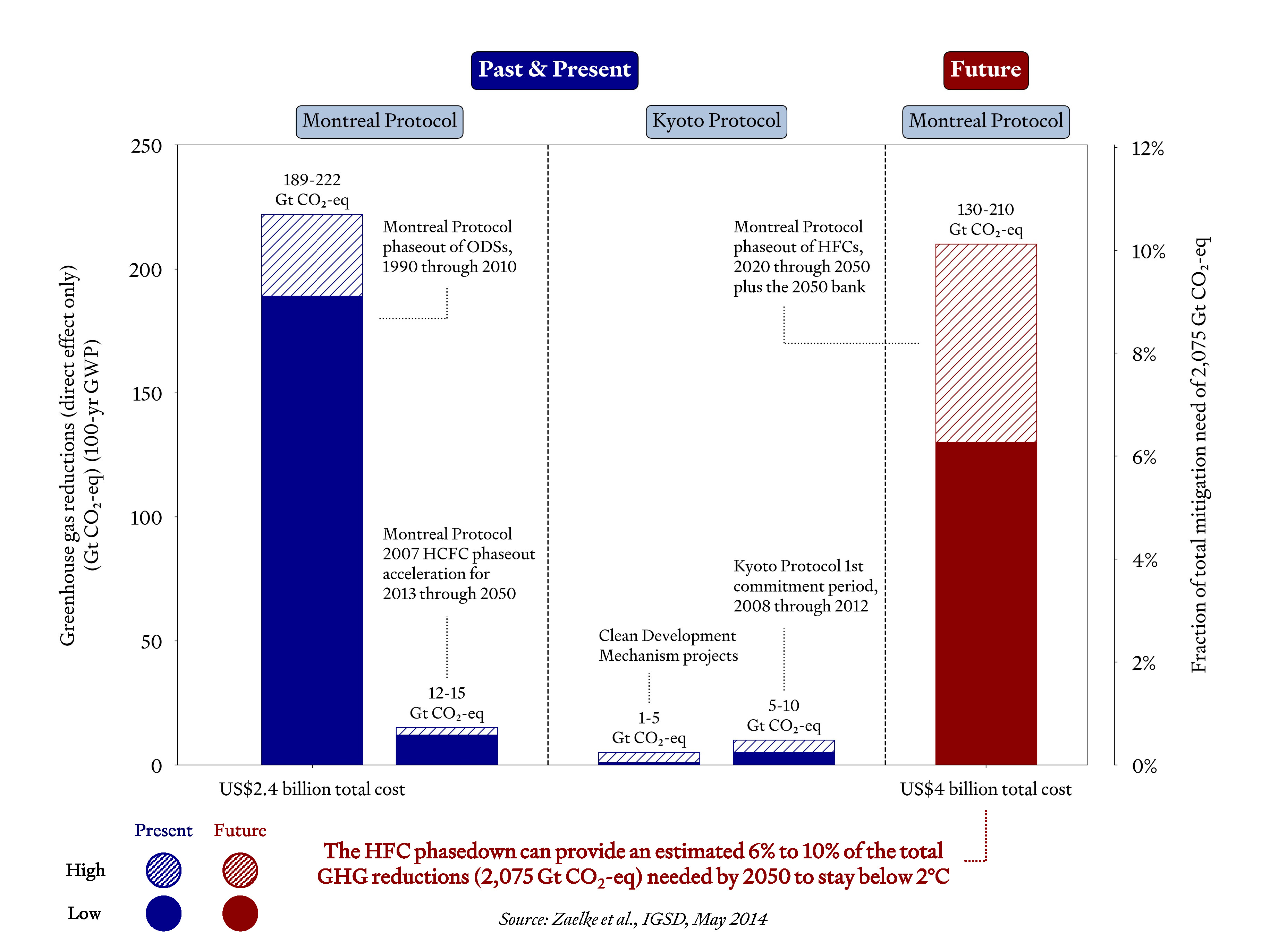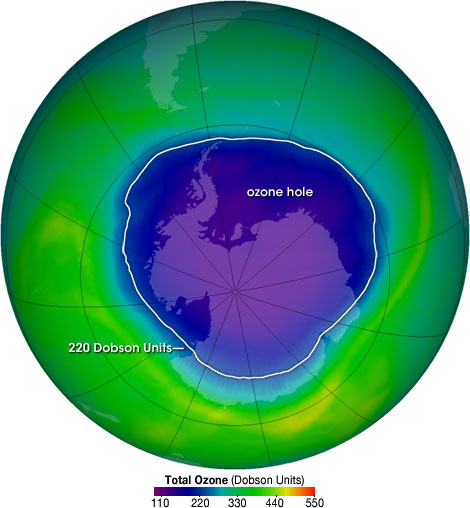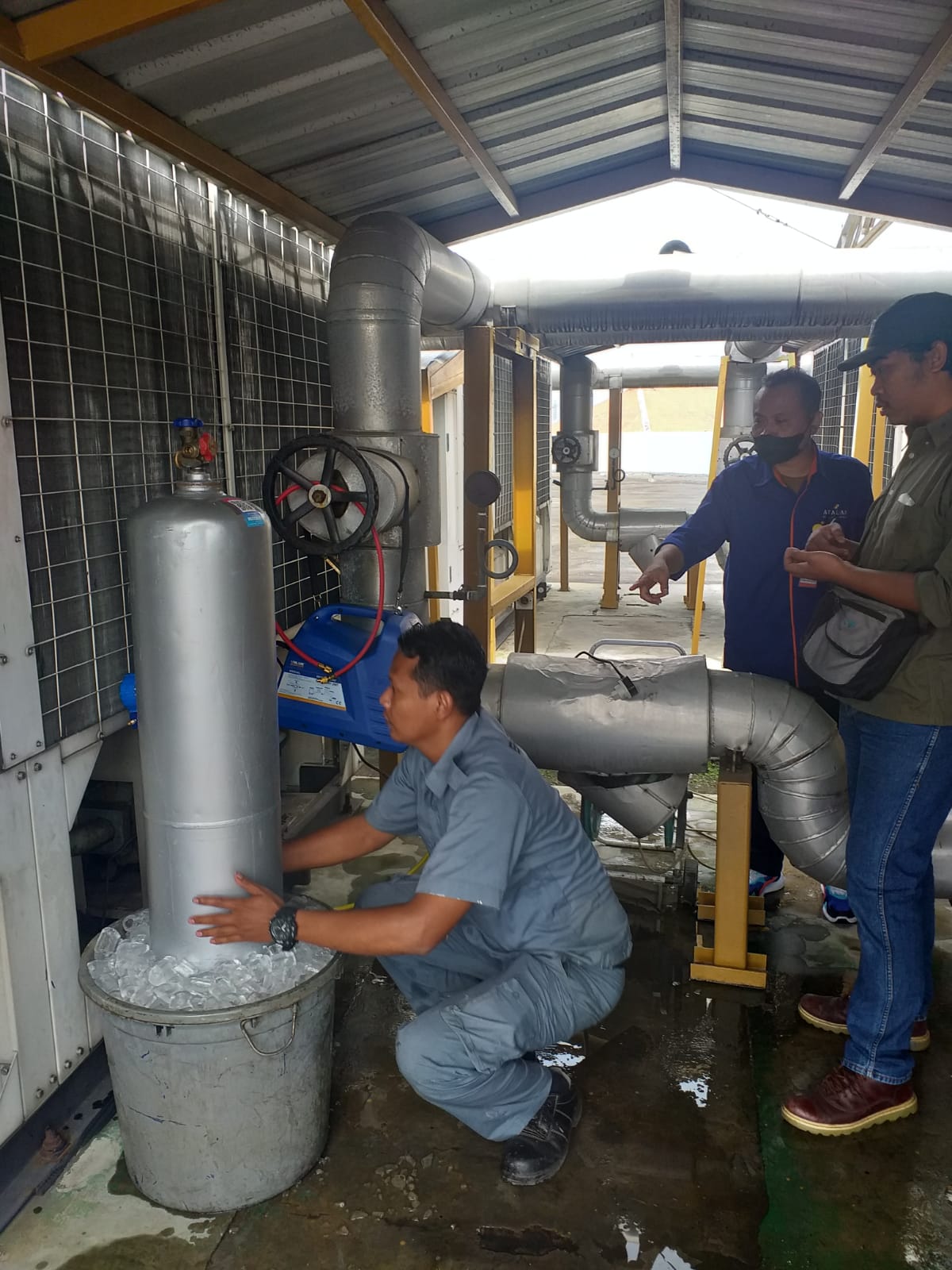The Montreal Protocol is already the world's most successful climate treaty, and it can do even more.
The world has already averted climate disaster once. Without the Montreal Protocol, the climate impacts projected for 2050 would have already arrived by 2000. Why don’t we hear more about it? The Montreal Protocol was originally designed to tackle a different environmental issue — the thinning of the ozone layer by man-made chemicals. Under the Protocol, countries are required to reduce the production of ozone depleting substances in a stepwise manner, with different schedules for developed and developing countries. Today, nearly 99% of ozone depleting substances are gone, and the ozone layer is on a path to recovery.
The chemicals which deplete the ozone layer are also extremely potent greenhouse gases that contribute to global climate change. By phasing out their production and use, the Montreal Protocol prevented up to 2.0 °C of warming: 1.0 °C from reduced emissions, and up to 1 °C from protecting forests and other carbon sinks from increased ultraviolet radiation due to ozone layer depletion.
Since its inception, the Montreal Protocol has been amended a number of times, each time furthering the speed and ambition of the transition towards more ozone and climate-friendly chemicals. These efforts were driven by people who believed that the Protocol could, and needed to do more. Most recently, the Montreal Protocol was expanded to mandate the phase down of HFCs through the Kigali Amendment in 2016. Now, with the inclusion of HFCs, the Montreal Protocol is estimated to prevent an additional 0.5°C of warming by 2100, and there is even more that can be done.
In this article, we describe the lessons that can be learned from the Montreal Protocol’s long run of success, and how they inform our work on HFCs and climate more broadly. We can learn from the failures that have caused our current climate emergency, but also from the successes of past environmental treaties. Now, more than ever, we must heed the urgent lessons from the Montreal Protocol to take fast action on climate change.

I. The Ozone Hole
The story begins in the 1970s, when scientists Mario J. Molina and F. Sherwood Rowland found that commonplace chemicals used in refrigeration, air-conditioning, and hairspray were eating away at the ozone layer. The majority of these chemicals fall under two groups: chlorofluorocarbons (CFCs) and hydrofluorocarbons (HCFCs), the latter being the less ozone-depleting, but still harmful alternative to CFCs. Without swift action, the thinning of the ozone layer would allow harmful UVB radiation to enter the atmosphere, causing millions more cases of skin cancer and crop failure worldwide. In the following years, there was a robust public response, especially in the United States. Even before the aerosol ban in 1978, domestic demand for spray cans had fallen by two-thirds. Molina and Rowland would go on to win the Nobel Prize for their work.
The issue captured the public imagination even more firmly in 1985, when British scientists discovered a region of exceptionally depleted ozone above Antarctica (deemed “the ozone hole”). The ozone hole appeared across television and media, heightening the pressure on governments to take action. Driven by a trust in science, a belief that substitutes could be developed, and a timely imperative to act, nations overcame substantial resistance to sign the Montreal Protocol on September 16th, 1987.

II. The Montreal Protocol: The Treaty that Works
How has the Montreal Protocol been able to achieve its success? Though ambitious in its aims, the Montreal Protocol has been pragmatic in its execution, taking an incremental approach to achieve aspirational goals. At the time of its inception, the end goal of rapidly phasing out ODS seemed far-fetched, as alternatives remained commercially unproven in many applications. Initially, the Protocol implemented a 50% phasedown, rather than a phaseout, and it only covered a limited subset of the most potent ozone-depleting gases.
As technological advances made replacements more cost-effective, the Protocol was able to do even more. Within 3 years, it was accelerated to a complete phaseout of CFCs on a shorter timeline. After another 2 years, in 1992, the phaseout was accelerated yet again, and HCFCs were brought under the Montreal Protocol’s regime. In 1997, the HCFC phasedown was accelerated to a phaseout, and in 2007, the timeline for HCFCs became even faster. And in 2016, the Kigali Amendment extended the Montreal Protocol even further to phase down HFCs.
The success of the Montreal Protocol rests on several key features:
Firm limits: The consumption and production limits set by the Montreal Protocol are legally binding, which is a feature that many treaties lack.
Enforceability: It has an Implementation Committee which effectively addresses non-compliance. Rather than taking a punitive approach, the Committee first focuses on getting to the root cause of problems with compliance, and sets out to help countries find solutions. Penalties for non-compliance, though they exist, are viewed as a last resort, and have seldom been used throughout the Protocol’s long history.
Common but differentiated responsibilities: The Protocol implements a delayed phasedown schedule for developing countries, which makes it more equitable and feasible. Developed countries help to build markets that make alternative chemicals cheaper and easier to access, lessening the burden for developing countries as they begin their phasedowns.
Financial support: To further support phasedown in developing countries, the Montreal Protocol has a financial mechanism called the Multilateral Fund (MLF). The MLF provides funding from developed countries to support less developed countries that otherwise may not have been able to meet their obligations.
III. The Road to Kigali
In 1998, looking back at the first 11 years of the Montreal Protocol, US lead negotiator Richard Benedick wrote that “With the benefit of hindsight, the Montreal Protocol seems to have acquired an aura of inevitability. For those who were not actually involved, there is a tendency not to remember how difficult it actually was to reach an agreement in 1987 to control ozone-depleting substances.” He cited scientific uncertainty, political opposition, industry hostility, and a lack of commercial alternatives to CFCs as sources of problems along the way. Not to mention the fact that, prior to the Montreal Protocol, an international environmental treaty of comparable scope and scale had never been achieved before. In light of this context, the subsequent victories under the Montreal Protocol are all the more remarkable.
Rather than resting on the laurels of an already immensely successful treaty, policymakers, scientists, and advocates have pressed onwards, delivering another string of successive agreements over the past 15 years. After a paper was published in 2007 detailing the climate benefits of the Montreal Protocol, there was a renewed desire to maximize its climate impacts. As a result, the timeline for phasing out HCFCs was accelerated in September 2007. This decision was significant not only because it reduced the amount of time for which HCFCs continue to be produced and used, but also because it enabled an earlier phasedown of HFCs through the 2016 Kigali Amendment.
HFCs were initially a solution to the ozone-depletion problem, as they have largely replaced HCFCs in refrigeration and air-conditioning. But though they are ozone-friendly, they are greenhouse gases thousands of times as potent as CO2. They are currently the most rapidly growing source of greenhouse gas emissions, as demand for cooling increases worldwide. The Kigali Amendment marks the first time that the Montreal Protocol targeted gases that were not ozone-depleting. The Kigali Amendment has been ratified by 148 parties, including the United States, which phases down HFCs through the American Innovation and Manufacturing Act of 2020 (AIM Act).

IV. Maximizing the Climate Benefits of the HFC Transition
Though the Kigali Amendment and the AIM Act move the needle, more can and must be done to mitigate refrigerant emissions in the next few decades to avoid the worst effects of climate change. CFCs, HCFCS, and HFCs are classified as short-lived climate pollutants (SLCPs) — a group of greenhouse gases which, due to their shorter lifetime in the atmosphere, represent the greatest opportunity to decrease warming in the near-term. In contrast with CO2, which can stay in the atmosphere for hundreds of years, SLCPs stay in the atmosphere for <20 years and cause an outsized influence on global temperatures during that time. As a result, fast action on SLCPs is needed to reduce peak temperatures and forestall the catastrophic tipping points that lay just beyond the horizon of 1.5°C of warming, which is quickly approaching. The good news is, there are many more steps that can be taken to reduce refrigerant emissions, both within and beyond the Protocol itself.
Though the Montreal Protocol effectively reduces the new production of refrigerants, it does not address refrigerants that are already in equipment today (often called the "installed refrigerant bank"). Managing the installed bank is one of the highest impact and most neglected ways to reduce HFC emissions in the near term. The installed refrigerant bank today totals 24 billion MTCO2e – equivalent to the annual emissions of 5 billion gas-powered cars. Without proper leak detection and recovering the gas at equipment servicing and end-of-life, nearly all of the installed bank will eventually be emitted into the atmosphere. Policy efforts and carbon markets can create better incentives for proper refrigerant management.
Since the Kigali Amendment implements a gradual phasedown, there is room for nations and organizations to go above and beyond their mandated requirements. With the support of first-movers, next-generation technologies will become cheaper, and barriers to implementation will be lessened. Following in the footsteps of earlier amendments to the Montreal Protocol, as more alternatives become available, the timeline for HFC phasedown can be accelerated.
Early implementation of next-generation cooling technologies can have a global effect. Developing countries still in the process of phasing out HCFCs often switch to HFCs with high global warming potentials (GWPs). However, with swift and collaborative efforts, it is possible for developing countries to “leap-frog” to low-GWP alternatives, which already exist in most sectors.
There are opportunities to extend the Montreal Protocol even further. In addition to accelerating the HFC phasedown, there are gases which have not yet been included in the Protocol, but fall within its purview. Nitrous oxide (N2O), is now the most dominant ODS being emitted today, and it is the third most dominant greenhouse gas, after CO2 and methane. Other fluorinated gases like perfluorocarbons (PFCs) and sulfur hexafluoride (SF6) are also potent greenhouse gases, and they present yet another promising opportunity to extend the Montreal Protocol.

V. Broader Lessons for Climate
The unprecedented results delivered by the Montreal Protocol were the result of decades of sustained effort and broad collaboration by nations, industry, and non-governmental bodies. Between official meetings, stakeholders and advocates worked together to imagine the possibilities of what the Montreal Protocol could accomplish.
The Montreal Protocol’s legacy of collaboration and perseverance is what we hoped to build upon by hosting a workshop at Yale University in 2023 on HFCs and publishing a report on the takeaways.
Though no treaty is perfect, the facts speak for themselves. The Montreal Protocol has delivered unprecedented results for the ozone layer and for the climate. In addition to phasing down HFCs, there are other ways that lessons from the Montreal Protocol can continue to inform climate efforts today:
Engaging the public: Good science and effective science communication brought attention to the ozone issue and informed the public. The public response was instrumental in convincing governments and companies to take action on ozone. Concerned consumers brought about the collapse of the CFC aerosol market in the United States and spurred companies to begin developing alternatives. Citizens, scientists, and the media each have a critical role to play in driving climate efforts forward.
An industry-specific approach: Part of the Montreal Protocol’s success comes from the fact that it narrowly targets a set of gases with a specific group of manufacturers and applications. The Protocol can provide a framework for designing binding global treaties to reduce the emissions of other super climate pollutants, starting with methane. It can also inform a sectoral approach to international climate negotiations, whereby different treaties exist for reducing emissions from different sectors, rather than a “one-size-fits all” approach.
Start and strengthen: The Montreal Protocol began with goals that were ambitious, but achievable, and it has grown in its scope and speed over time, as phasedown protocols have become more established and new technologies have developed. Beginning with firm, but realistic goals creates the market for new technologies and maintains a stable environment for investment.
Continued ambition: The achievements of the Montreal Protocol were not inevitable. They were the result of decades of sustained effort and the belief that such results were both possible and necessary. The story of the Montreal Protocol shows that seemingly unlikely success can be achieved through perseverance and collaboration. With determination and belief, past successes can be pushed even further.
Today, the Montreal Protocol serves as a reminder that we can come together to solve our greatest challenges. And there is ever yet more to be done. We must stay hopeful and ambitious as we work together to ensure a better future for people and the environment. The world needs no less.
